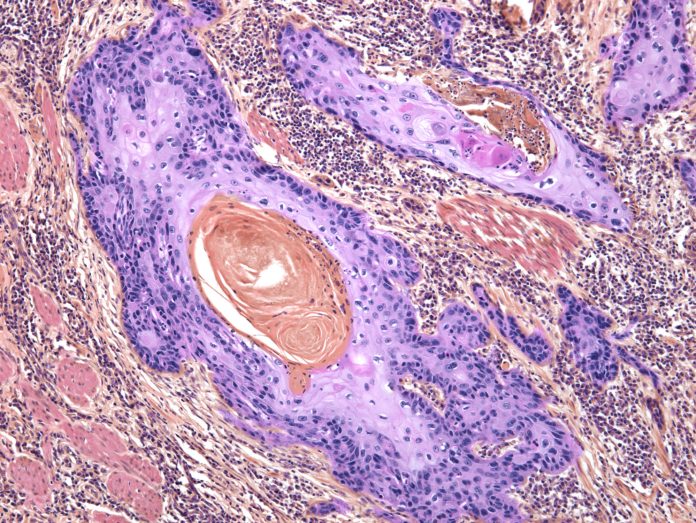
A team of Moffitt Cancer Center researchers, in collaboration with NFlection Therapeutics and researchers at Stanford University, have identified a new drug, NFX-179, that can be applied to the skin and was shown to prevent the development of cutaneous squamous cell carcinoma in preclinical models.
Cutaneous squamous cell carcinoma is the second most common type of skin cancer in the United States, affecting nearly 700,000 people each year. While the cancer is typically treatable through surgical removal, approximately five percent of cases progress to a more advanced stage, requiring additional therapy. Given the high incidence and potential mortality associated with advanced disease, scientists have been exploring the development of drugs preventing the condition. Reporting in Science Translational Medicine, researchers have now identified a drug candidate bringing them one step closer to the goal of disease prevention.
Kenneth Tsai, PhD, vice chair of research pathology and a senior member of the Cancer Biology & Evolution Program, elaborated on their findings, “Our previous work showed that the canonical mitogen-activated protein kinase (MAPK) signaling pathway is important for the development of cutaneous squamous cell carcinoma. Our new study expanded on this, by showing that drugs targeting the extracellular signal-regulated kinase (ERK) MAPK pathway, including MAP2K / MEK inhibitors, may be an effective approach for prevention.”
Though several MEK inhibitors are approved for advanced cancer treatments, they are administered orally and come with associated side effects that limit their continuous use, particularly in a preventive context.
To overcome these limitations, Tsai and his team aimed to develop a topical drug targeting the MEK1/2 proteins with minimal to no side effects. This drug needed to penetrate the upper epidermal and lower dermal layers of the skin while maintaining high potency and quick clearance from circulation to reduce side effects.
After screening over 100 compounds, the researchers identified NFX-179 as a fitting candidate. Preclinical experiments in mouse models revealed that a gel formulation of NFX-179 reduced the formation of new cutaneous squamous cell carcinomas by up to 92 percent at the highest doses. Importantly, the effects of NFX-179 gel were localized, with the inhibition of carcinoma development observed only in the treated areas. Furthermore, no systemic toxicities were noted, suggesting that this drug might be safe and well-tolerated.
“Our data provide compelling rationale for using metabolically labile topical MEK inhibitors such as NFX-179 as an effective strategy for cutaneous squamous cell carcinoma chemoprevention. NFX-179 gel appears safe, tolerable, and highly efficacious in preclinical model systems,” Tsai commented.
The introduction of NFX-179 brings new hope to the fight against cutaneous squamous cell carcinoma. According to the researchers, its localized application and minimal side effects offer a promising path towards preventive strategies, reducing the burden of this common and potentially lethal skin cancer. While further clinical trials are needed to determine its efficacy in humans, NFX-179 represents a significant breakthrough in the field of skin cancer prevention and treatment.












